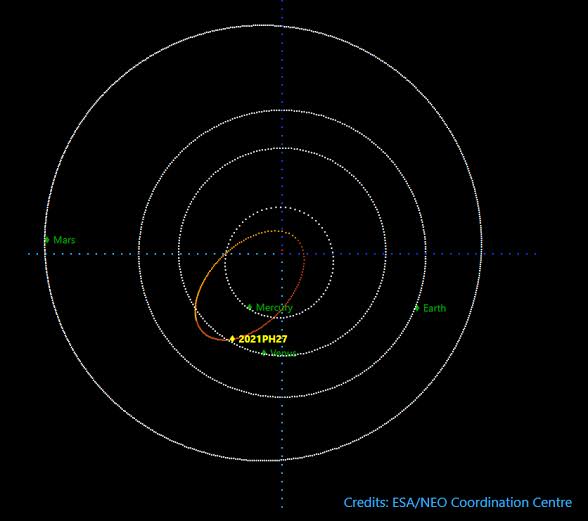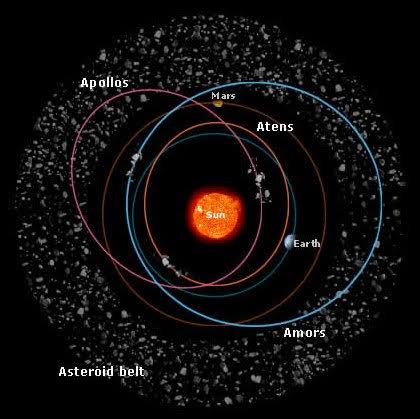In the evening sky, astronomers have discovered three previously undiscovered near-Earth asteroids. The largest potentially dangerous asteroid found in the last eight years is one of them.
It is on an orbit that could someday bring it dangerously close to Earth; it is around 1.5 kilometers (almost 1 mile) across.
The courses of the other two asteroids are completely and safely closer to the Sun than the orbit of the Earth. Even yet, their discovery is nonetheless thrilling since it adds to a list of elusive objects that will help us classify the population of near-Earth objects.
The Unidentified Objects
At orbital distances greater than Earth’s, the majority of the Solar System’s minor planets—objects in direct orbit around the Sun that are neither plants nor comets—have been found. There are numerous additional rocks, including Greek and Trojan asteroids that circle in close proximity to one another, as well as the asteroid belt between Mars and Jupiter, the Kuiper Belt past Neptune, where Pluto is located.
Why Haven’t There Been Many Small Planet Discoveries Closer To The Sun?
There is a very excellent reason why there haven’t been many small planet discoveries closer to the Sun. We must direct our gaze toward a large, brilliant star, whose overwhelming brightness effectively renders small, dull asteroids undetectable. This means that as we look away from the Sun and toward the outer Solar System, we are more likely to locate things.
Astronomers must wait until dawn or sunset when the Sun’s glare is mostly below Earth’s horizon and provides just enough light to illuminate any potential inner Solar System asteroids before they have a chance of finding one.
Such a study of vast areas of the sky closer to the Sun than Earth and Venus was carried out by a research team led by astronomer Scott S. Sheppard of the Carnegie Institution for Science, yielding some surprising findings.
2021 PH27

One of them was the asteroid 2021 PH27, which has the shortest orbit of any asteroid discovered to date at only 113 days. Then there is 2021 LJ4, which likewise completes a full orbit around the Sun inside that of Earth. They are both classified as Atira asteroids.
“We have discovered two planet-killing-sized near-Earth asteroids that are around a kilometer across,” according to Sheppard.
“There are probably only a few similarly sized near-Earth asteroids left to locate, and these sizable undiscovered asteroids most likely have orbits that keep them mostly inside the orbits of Venus and Earth. Due to the challenges of detecting close to the Sun’s glare, only around 25 asteroids with orbits entirely within Earth’s orbit have been found to date.”
The Apollo Asteroids

An Apollo asteroid is 2022 AP7, the third asteroid. These are asteroids that travel in elliptical routes from a region closer to the Sun to a region outside of Earth’s orbit. The Apollo asteroids 2022 AP7 and others could approach our planet close enough to cause a collision by crossing our orbit, making them “potentially hazardous” asteroids.
Thankfully, we are aware of about 2,000 potentially dangerous asteroids, the largest of which is around 7 kilometers across. Knowing about them allows us to model their orbits and determine when and if they are likely to pass dangerously close to Earth. If we had enough time to react, we might be able to alter their direction by ramming a spacecraft into their surface.
Atira Asteroid
It’s crucial to find new Atira asteroids. The majority of our knowledge of the Solar System’s minor planet population comes from a survey of outlying space rocks. Knowing more about the inner Solar System can help us create more precise models of the system’s evolution over time and learn more about how asteroids are carried to various parts of the system.
According to Sheppard, “our DECam scan is one of the largest and most sensitive searches yet made for objects in Venus’ orbit and within Earth’s orbit.” “This is a rare opportunity to comprehend the kinds of objects that are hiding in the inner Solar System.”
Conclusion
Interestingly, the survey has found a greater number of larger asteroids, those at least a kilometer in diameter, despite being more sensitive to smaller objects. This could imply that smaller asteroids are less stable in the inner Solar System or more prone to disintegrating under the harsh gravitational and temperature conditions found there.
However, it could just be because tiny asteroids are more difficult to find. This is a compelling argument in favor of future polls that are more delicate.
